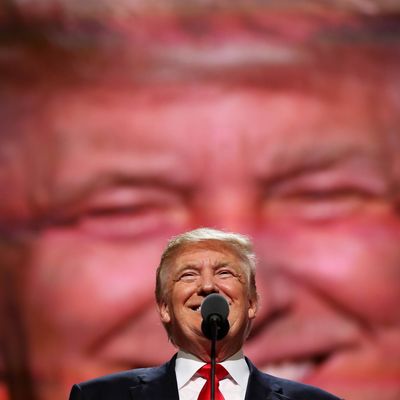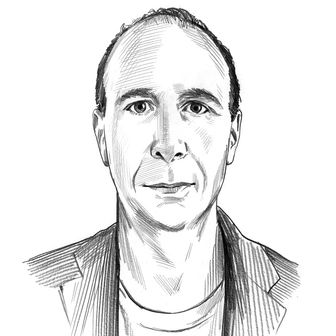
The first three nights of the Republican convention turned in a halfhearted and largely unsuccessful effort to draw Donald Trump closer to the party he conquered. Here are speeches about the bills from Paul Ryan and Mitch McConnell he will sign, the right-wing judges he will appoint, not to mention testimonial from women and minorities he has never harassed or offended. The final night is the one in which Trump fully consummated his conquest.
Trump’s acceptance speech is one of the most memorable and important ones ever delivered at a convention, because it reflects a conscious effort to alter the ideological orientation of its party. The speech bears the heavy imprint of its reported author, Stephen Miller, a very smart, renegade Republican staffer who advocates what he calls “nation-state populism.” Pat Buchanan, a sympathetic observer from a previous era, has described the ideology somewhat more bluntly and pithily as “ethnonationalism.” Ethnonationalism is a form of conservatism, and overlaps with standard-issue Republican conservatism in several ways, but the two philosophies diverge in ways that can leave their adherents bitterly at odds. (Buchanan worked for Richard Nixon and Ronald Reagan, but ran as a primary opponent of George Bush and Bob Dole, and left the party altogether to oppose George W. Bush.) Programmatically, ethnonationalists differ from standard issue Republicans like George W. Bush or Paul Ryan in that they oppose free trade and immigration. Their orientation is nostalgic, rather than glitter-eyed about the future. Like traditional conservatives, they distrust federal power, but extend their circle of rhetorical enemies to include the corporate elite. Most important, unlike standard conservatives, who tend to disregard race, ethnonationalists have a deeply, explicitly, racialized view of the world.
All those ideological markers appeared in Trump’s address. The speech focused on four issues: crime, trade, immigration, and terrorism. The first three are issues most Republicans have de-emphasized, or moved in the opposite direction advocated by Trump. The last, terrorism, he presented less as a foreign-policy problem — as Republicans usually do — than as an outgrowth of an immigration policy he believes should exclude Muslims. Virtually the entire speech was therefore consumed with what, from the standpoint of almost any traditional Republican leader, would be heresy.
The most important divergence was the question of race. Trump’s speech could be compared in some ways to Pat Buchanan’s 1992 address, which famously (or notoriously) cast the country as divided into a culture war. But unlike Buchanan’s speech, Trump’s contained hardly any sexual or religious component. Family life and the transmission of social values through parents and communities — hardy social-conservative themes — were nowhere to be found. Indeed, Trump reached out to LGBT citizens, as victims of Islamic terrorism, placing on the “us” side of his fence a group Buchanan had identified as one of “them.” Instead, Trump defined the culture war almost entirely in racial terms.
Trump fixated on preliminary evidence of a rise in violent crime, which has risen over the last year, after a quarter-century fall. If the longstanding drop in violence does reverse itself in a sustained way, a trend that can only be intimated now, it would merit real concern and potentially justify a reexamination of policies. But the preliminary spike in crime is Trump’s point of departure for full-scale hysteria — “violence in the streets,” “chaos in our communities.” Nor does he draw upon any theory of criminology, or offer tangible solutions of any kind. The solution, simply is the replacement of President Barack Obama with President Donald Trump, at which point, “Beginning on January 20, of 2017, safety will be restored.”
Why would the mere presence of Trump in the White House, absent any policy revolution he can promise, restore safety? Because Trump ascribes the recent rise in violence to Obama. Here is the most nakedly revealing sentence in Trump’s speech, and the axis upon which most of his argument turns: “The irresponsible rhetoric of our president, who has used the pulpit of the presidency to divide us by race and color, has made America a more dangerous environment than frankly I have ever seen.” Factually, this is preposterous. Obama does not denigrate white people, who supply most of his votes. The president’s rhetoric and policy on race are relentlessly inclusive, to the frequent frustration of the left. What’s more, Trump’s chronology does not make sense. If Obama’s rhetoric has caused crime to rise in his eighth year, why has crime fallen through the first seven?
But the imagined role of Obama as racial provocateur is the fantasy that holds Trump’s worldview together. Unlike Obama, who balances sympathy for victims of police violence against sympathy for police, Trump does not mention the recent spate of police shootings of African-American men who had surrendered and posed no threat, nor to the long history of excessive violence against, combined with under-policing of, African-American neighborhoods, nor to the existence of racism at all. When he does portray nonwhite Americans as victims and not just perpetrators, they are victims of Obama and the global elite.
Trump’s treatment of immigration is equally raw. He fixates on a handful of murders committed by undocumented immigrants, falsely implying that people here illegally are more likely to commit crimes. Again, the absence of programmatic detail is telling. Trump does not explain how he will locate and round up the 11 million people in the country without authorization. Nor does he explain how he will screen out the Muslim immigrants with hostile beliefs. “I only want to admit individuals into our country who will support our values and love our people,” he says, “Anyone who endorses violence, hatred or oppression is not welcome in our country and never will be.” So the test is to ask every refugee or immigrant if they endorse violence?
There is hardly any more meat on the bones of any of the rest of Trump’s promises. He promises that new trade agreements will be with individual countries, not with more than one country. But the most harmful trade measure was a series of bilateral agreements with China. Trump insists “no one from our country even reads or understands” trade agreements, probably because the notion of anybody reading something long and detailed is unfathomable to him. The rest of his promises are empty to the point of comedy, conjuring trillions of dollars for tax cuts and new infrastructure by magic.
Trump famously elides any specific objection to his grandiose promises by offering his own alleged business genius as the cure-all, and he did so again tonight. This fantasy megalomania, Trump as the magical savior, is the most ridiculous feature of Trump’s candidacy. What makes his acceptance speech new and different is that he offers more than just himself as the solution. He offers his supporters a restoration of the social order Obama inverted. Trump’s election will not only make Trump the president, it will represent white America attaining the necessary level of collective consciousness, rising as one.






























